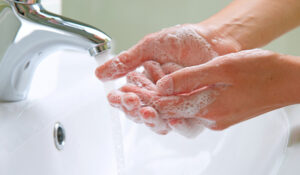Norovirus: symptoms and prevention

Norovirus is the most common type of gastroenteritis, causing stomach or intestinal inflammation and many outbreaks of Norovirus occur all year long from contaminated food. Each year, in the United States, norovirus affects around 20 million cases of acute gastroenteritis according to The Center for Disease Control and Prevention. Norovirus is contagious and outbreaks are more likely to happen in crowded and closed places where the virus can quickly spread between people. Most of them occur in the food industry like restaurants because of infected food workers whom touch raw fruits and vegetables with bare hands before serving them. Norovirus is sometimes called gastric flu even if it is not related to influenza.
Anyone can be infected with norovirus and get sick. People are the most contagious when sick, and during the first few days after the recovery. There is no specific cure for norovirus. It’s usually mild and shouldn’t last more than a couple of days.
Symptoms
The virus causes your stomach or intestines or both to get inflamed engendering the following symptoms:
– diarrhoea
– throwing up
– nausea
– stomach pain
– fever
– headache and body aches
If you experience more serious symptoms or if they don’t disappear after a few days, you should consult your doctor.
How does norovirus spread?
Like most viruses, norovirus spread through direct contact with an infected person, stools, contaminated food or water. Touching contaminated surfaces and then your face can infect you. Norovirus can be present in your vomit and stool even before symptoms of infection appear and can stay in your stool for 2 weeks or more after recovery.
To reduce the risk of infection
Practice good hand hygiene
Wash your hands with soap and water for at least 30 seconds, especially after using the toilet and changing diapers, and always before eating, preparing, or handling food. Use an [alcohol-based hand sanitizer] if soap and water aren’t available or in addition to hand washing.
Wash fruits and vegetables and cook seafood
Wash fruits and vegetables thoroughly before preparing and eating them. Cook oysters and other shellfish before eating them.
If you are sick, avoid preparing food and caring for people who are sick
The virus is highly contagious and spread easily through food. You should not prepare food for others or provide healthcare while you are sick for at least 3 days after symptoms stop.
Keep sick infants and children out of areas where food is prepared.
Clean and disinfect surfaces
Touching a contaminated surfaces and then touching your face is enough to infect you. Often wipe down surfaces with an alcohol based solution to avoid cross contamination.
Wash laundry thoroughly
Thoroughly wash your clothes and linens if they are contaminated with vomit or stool.
Sources:
CDC. 2013. U.S. Trends and Outbreaks. [ONLINE] Available at: http://www.cdc.gov/norovirus/trends-outbreaks.html.
Mayo Clinic. 2014. Norovirus Infection. [ONLINE] Available at: http://www.mayoclinic.org/diseases-conditions/norovirus/basics/symptoms/con-20029968.
CDC. 2013. Norovirus Overview. [ONLINE] Available at: http://www.cdc.gov/norovirus/about/overview.html.







